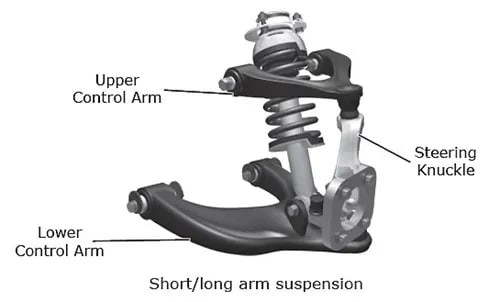A car’s suspension system is crucial for a smooth and safe ride. It absorbs shocks from bumps and uneven road surfaces, ensuring the tires maintain contact with the road for optimal control and stability. This comprehensive guide delves into the intricacies of Car Suspension, exploring its components, functions, types, and common signs of wear and tear.
Understanding the Role of Car Suspension
The primary function of a car suspension is to maximize the friction between the tires and the road surface. This constant contact ensures steering stability, good handling, and a comfortable ride by absorbing vibrations and impacts from the road. Without a properly functioning suspension system, driving would be a jarring and potentially dangerous experience. The suspension system allows the car body and frame to remain relatively stable while the wheels navigate uneven terrain.
Key Components of a Car Suspension System
Several components work together to form the complex system that is car suspension:
- Coil Springs: These metal coils absorb the impact from bumps and dips in the road, smoothing out the ride.
- Shock Absorbers: Working in tandem with coil springs, shock absorbers dampen the spring’s oscillations, preventing excessive bouncing and maintaining tire contact.
- Struts: These structural components often combine the functions of a shock absorber and coil spring into a single unit, providing support and damping. They play a vital role in load-bearing and steering control.
- Control Arms: These hinged links connect the chassis to the wheel hub assembly, allowing the wheels to move up and down while maintaining alignment. They are essential for controlling wheel movement and ensuring proper geometry.
- Ball Joints: These spherical joints allow for rotational movement in the control arms, enabling the wheels to turn and articulate while maintaining a secure connection. They are crucial for steering and suspension articulation.
Types of Car Suspension Systems
Two main types of suspension systems exist:
- Dependent Suspension: This system utilizes a rigid axle connecting both wheels on an axle. While robust and suitable for heavy loads, it offers less independent wheel movement, resulting in a less smooth ride. It’s commonly found in trucks and older vehicles.
- Independent Suspension: Each wheel has its own suspension system, allowing for independent movement and better adaptation to road irregularities. This system provides improved handling, comfort, and tire contact. It is the standard in most modern passenger vehicles.
Recognizing Signs of Worn Car Suspension
Identifying worn or damaged suspension components is crucial for safety and vehicle performance. Common indicators include:
- Pulling or Drifting: The vehicle veering to one side while driving can indicate worn shocks or struts.
- Uneven Ride Height: One corner of the car sitting lower than others suggests a problem with springs or other components on that side.
- Excessive Bouncing: A bouncier than usual ride points towards worn shocks or struts.
- Clunking or Knocking Noises: Unusual sounds when driving over bumps often signal worn ball joints, control arm bushings, or other suspension components.
- Vibrations in the Steering Wheel: Vibrations felt through the steering wheel may indicate worn tie rod ends or other steering and suspension components.
- Uneven Tire Wear: Premature or irregular tire wear patterns can result from a misaligned suspension system.
Maintaining Your Car’s Suspension
Regular maintenance is essential for optimal suspension performance and longevity. This includes:
- Regular Inspections: Visually check for leaks, damage, or wear in suspension components.
- Wheel Alignment: Ensure proper wheel alignment to prevent uneven tire wear and handling issues.
- Prompt Repairs: Address any signs of wear or damage immediately to prevent further problems.
- Adhere to Manufacturer Recommendations: Follow the recommended maintenance schedule for suspension-related services.
Conclusion
The car suspension system is a complex and vital component for a safe and comfortable driving experience. Understanding its function, components, and maintenance requirements empowers car owners to ensure optimal vehicle performance and safety on the road. Regular inspection and timely repairs are key to maintaining a well-functioning suspension system and extending the life of your vehicle.

